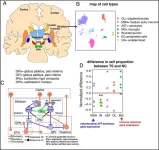(Press-News.org) Food additive mixtures are an everyday feature of our diets, especially through ultra-processed foods. Until recently, safety evaluations of these additives have been conducted substance by substance due to a lack of data on the effect of them ingested together. In a new study, researchers from Inserm, INRAE, Sorbonne Paris Nord University, Paris Cité University and Cnam, as part of the Nutritional Epidemiology Research Team (CRESS-EREN), examined the possible links between exposure to mixtures of commonly consumed food additives and the onset of type 2 diabetes. They analysed the health data of over 100 000 adults participating in the French NutriNet-Santé cohort. Two out of the five mixtures tested were found to be associated with a higher incidence of type 2 diabetes, particularly one mixture containing different emulsifiers such as carrageenans, modified starches and other additives (found in stocks, milky desserts, fats and sauces, etc.), and another containing sweeteners, colourings and acidifiers (characteristic of artificially-sweetened drinks and sodas). Their findings have been published in Plos Medicine.
Widely used by the agri-food industry, food additives are mainly found in the ultra-processed products sold in our supermarkets. The scientific literature now provides information on the potential harmful effects of consuming several of these substances, which have been associated with the development of metabolic disorders, chronic inflammation and gut microbiome imbalance. Recent studies from the NutriNet-Santé cohort have also revealed an association between the consumption of some of these additives and an increased risk of type 2 diabetes, cancer and cardiovascular diseases.
Although these studies provide insights into the individual effect of each of these substances, no study had yet looked at the possible impact of their combined consumption. And this is despite ultra-processed foods often containing mixtures of food additives, each with its specific properties (preservatives, flavour enhancers, colourants, texture agents, etc.).
To measure the consequences of exposure to these mixtures, a research team led by Mathilde Touvier, Inserm research director and study coordinator, analysed the health data of 108 643 adults in the NutriNet-Santé cohort over an average follow-up period of 7.7 years.
The participants completed at least two days (up to 15 days) of online dietary records of all food and drink consumed and their brands.
In order to obtain a reliable estimate of the exposure to additives and to focus on those with a potentially significant health impact, only those additives consumed by at least 5% of the cohort were included in mixture modelling. The presence or absence of each additive in each food was determined by cross-referencing several databases, taking into account the date of consumption (to incorporate any reformulations over time), as well as some laboratory assays of quantitative levels of additives in the food.
Five main mixtures of additives were identified, representing groups of substances frequently ingested together (due to their joint presence in industrially processed products or resulting from the co-ingestion of foods often consumed together).
The results show two of these mixtures to be associated with a higher incidence of type 2 diabetes, regardless of the nutritional quality of the diet (intake of sugar, calories, fibre, saturated fat, etc.) and sociodemographic and lifestyle factors. No associations were found for the other three mixtures.
The first mixture incriminated was primarily composed of several emulsifiers (modified starches, pectin, guar gum, carrageenans, polyphosphates, xanthan gum), a preservative (potassium sorbate) and a colouring agent (curcumin). These additives are typically found in a variety of ultra-processed foods, such as stocks, milky desserts, fats and sauces.
The other mixture implicated was primarily composed of additives found in artificially-sweetened drinks and sodas. It contained acidifiers and acidity regulators (citric acid, sodium citrates, phosphoric acid, malic acid), colouring agents (sulphite ammonia caramel, anthocyanins, paprika extract), sweeteners (acesulfame-K, aspartame, sucralose), emulsifiers (gum arabic, pectin, guar gum) and a coating agent (carnauba wax).
In this study, interactions between the additives of these mixtures were detected suggesting that some could interact with each other, either by enhancing their effects (synergy) or by attenuating them (antagonism).
“This study is the first to estimate exposure to food additive mixtures in a large cohort of the general population and to analyse their link to the incidence of type 2 diabetes. The findings suggest that several emblematic additives present in many products are often consumed together and that certain mixtures are associated with a higher risk of this disease. These substances may therefore represent a modifiable risk factor, paving the way for strategies to prevent type 2 diabetes,” explains Marie Payen de la Garanderie, PhD student at Inserm and first author of this research.
"Further studies are needed to elucidate the underlying mechanisms and deepen the understanding of the potential synergies and antagonisms between these substances. This observational study alone is not sufficient to establish a causal link. However, our findings are in line with recent in vitro experimental work suggesting possible cocktail effects[1]. They indicate that the evaluation of additives should take into account their interactions and support public health recommendations that advise limiting non-essential food additives,” explains Dr Touvier.
NutriNet-Santé is a public health study coordinated by the Nutritional Epidemiology Research Team (CRESS-EREN, Inserm/INRAE/Cnam/Sorbonne Paris Nord University/Paris Cité University) which, thanks to the commitment and loyalty of over 180 000 participants (known as Nutrinautes), advances research into the links between nutrition (diet, physical activity, nutritional status) and health. Launched in 2009, the study has already given rise to over 300 international scientific publications. In France, a drive to recruit new participants is still ongoing in order to continue to advance public research into the relationship between nutrition and health.
By devoting a few minutes per month to answering questionnaires on diet, physical activity and health through the secure online platform etude-nutrinet-sante.fr, the participants contribute to furthering knowledge towards a healthier and more sustainable diet.
[1] Cynthia Recoules, Mathilde Touvier, Fabrice Pierre, Marc Audebert. Food Chem Toxicol. 2025 Feb:196:115198. doi: 10.1016/j.fct.2024.115198. Epub 2024 Dec 14. Evaluation of the toxic effects of food additives, alone or in mixture, in four human cell models.
END
Certain food additive mixtures may be associated with an increased risk of type 2 diabetes
2025-04-08
ELSE PRESS RELEASES FROM THIS DATE:
Mouse brains register the difference between touching something and being touched
2025-04-08
Though the sense of touch underlies how we and most other animals interact with the world around us, much remains unknown about how this sense is processed in the brain. Researchers from Heidelberg University and Ludwig Maximillan University Munich in Germany measured the neuronal activity differences between active touch and passive touch in mice. As reported April 8th in the open-access journal, PLOS Biology, the researchers find that active and passive touch are processed by different pathways in the brain.
Active touch can be thought of as grabbing something with your hand, while passive ...
Researchers identify safer pathway for pain relief
2025-04-08
University of Florida scientists have helped identify a novel drug compound that selectively activates pain-altering receptors in the body, offering a potentially safer alternative to conventional pain medications.
In a new study published in Nature Communications, researchers describe how this drug compound provides pain relief without the dangerous side effects commonly associated with opioids administered to patients. The National Institutes of Health funded the study.
The human body relies on three kinds of opioid receptors to regulate pain, much like traffic control systems on a busy highway. Understanding these pathways ...
Cleveland Clinic-led trial is the first to show a delay in confirmed disability progression in non-relapsing secondary progressive multiple sclerosis
2025-04-08
Tuesday, April 8, 2025, Cleveland: A Cleveland Clinic-led clinical trial of tolebrutinib, an investigational oral Bruton’s tyrosine kinase inhibitor, a group of drugs originally developed to treat lymphomas and related blood disorders, demonstrated a 31% delay in the onset of six-month confirmed disability progression (CDP) in patients with non-relapsing secondary progressive multiple sclerosis (SPMS).
The first peer-reviewed results of the Phase 3 HERCULES trial published online today in the New England Journal of Medicine and were simultaneously presented during a clinical trials plenary session at the American Academy of Neurology 2025 ...
Community Review Board votes against public health care merger in Oregon after doctors group raises concerns about university’s primate research center
2025-04-08
PORTLAND, Ore. — The Physicians Committee for Responsible Medicine is lauding a Community Review Board after it voted unanimously on Monday to reject a merger between Oregon Health & Science University (OHSU), which houses one of seven primate research centers left in the United States, and Legacy Health.
“Instead of showing a real focus on patient care and ethical behavior, OHSU has been wasting money on drug, alcohol, and sex experiments on monkeys, and the public knows it,” said Neal Barnard, MD, FACC, ...
Groundbreaking study reveals changes in brain cell composition and gene activity in Tourette syndrome
2025-04-08
Philadelphia, April 8, 2025 – In the first comprehensive, cell-by-cell analysis of brain tissue from individuals with Tourette syndrome, researchers have pinpointed exactly which cells are perturbed and how they malfunction, revealing how different types of brain cells are affected by the condition. Findings from this groundbreaking study in Biological Psychiatry, published by Elsevier, provide unprecedented insights into the interplay of different brain cell types in Tourette syndrome, suggesting new therapeutic directions.
What makes this study particularly groundbreaking ...
ALS drug effectively treats Alzheimer’s disease in new animal study
2025-04-08
Experimental drug NU-9 — a small molecule compound approved by the U.S. Food and Drug Administration (FDA) for clinical trials for the treatment of amyotrophic lateral sclerosis (ALS) — improves neuron health in animal models of Alzheimer’s disease, according to a new Northwestern University study.
Like ALS, Alzheimer’s disease also results from misfolded proteins that damage brain health. Rather than treating symptoms from specific diseases, NU-9 instead addresses the underlying mechanisms of disease. Results from the new study give scientists hope that the drug should demonstrate effectiveness in the common ...
Breakthrough research revolutionizing pulmonary hypertension treatment
2025-04-08
A recent publication in the International Journal of Cardiology, Pulmonary artery denervation in pulmonary hypertension: A comprehensive meta-analysis, has shed light on the potential of pulmonary artery denervation (PADN) as an innovative intervention for pulmonary hypertension (PH), a condition that places patients at risk for right heart failure and death. Co-authored by Dr. James Jenkins, a cardiologist at Ochsner Health, the study analyzed data from multiple clinical trials to assess the therapeutic and clinical impact of PADN ...
More CPR education planned for Charlotte community with The David & Nicole Tepper Foundation
2025-04-08
CHARLOTTE, April 8, 2025 — The American Heart Association and The David & Nicole Tepper Foundation (DNTF) have teamed up to increase bystander cardiopulmonary resuscitation (CPR) and automated external defibrillator (AED) education through the Association’s Nation of Lifesavers™ movement. DNTF’s $600,000 commitment to support training in Charlotte youth sports will help prepare coaches, athletes and sports leagues officials to respond immediately and appropriately in a cardiac emergency situation. DNTF’s gift will also support CPR education within the Mecklenburg County Sheriff’s Department as well as affordable housing communities.
“This ...
When protective lipids decline, health risks increase
2025-04-08
New research from Weill Cornell Medicine has uncovered a surprising culprit underlying cardiovascular diseases in obesity and diabetes—not the presence of certain fats, but their suppression. The study, published Feb. 25 in Nature Communications, challenges the conventional belief that a type of fat called ceramides accumulates in blood vessels causing inflammation and health risks. Instead, their findings reveal that when ceramides decrease in endothelial cells lining blood vessels, it can be damaging and cause chronic illnesses. Ironically, the findings ...
Society for Laboratory Automation and Screening announces $100,000 Graduate Education Fellowship Grant awarded to Vasu Rao of the University of Michigan
2025-04-08
Oak Brook, IL (USA) – The Society for Laboratory Automation and Screening (SLAS) is pleased to announce Vasumitra “Vasu” Rao, M.S., Ph.D. candidate in the Biomedical Engineering program at the University of Michigan (Ann Arbor, Michigan, USA), as the 2025 SLAS Graduate Education Fellowship Grant recipient.
Rao’s innovative work at the intersection of artificial intelligence (AI), laboratory automation and microbiology exemplifies SLAS’s mission to support emerging leaders in quantitative biosciences through the grant.
The awarded funding will enable Rao to continue his research under advisor Paul Jensen, Ph.D. (Assistant Professor of Biomedical Engineering) ...



